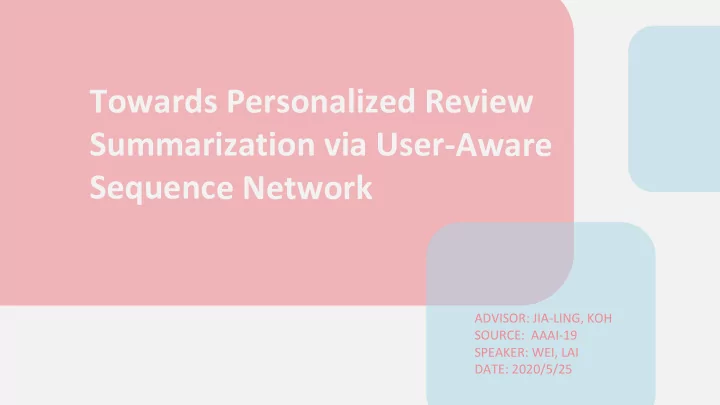

Towards Personalized Review Summarization via User-Aware Sequence Network ADVISOR: JIA-LING, KOH SOURCE: AAAI-19 SPEAKER: WEI, LAI DATE: 2020/5/25
OUTLINE 01 03 INTRODUCTION EXPERIMENTS 02 04 METHOD CONCLUSION 2
4
User-aware Sequence Network (USN) Review summarization aims to generate a condensed summary for a review or multiple reviews. INTRODUCTION Different users may: Care about different contents ● Have their own writing styles ● 3
METHOD User-aware Sequence Network (USN) 5
Problem Formulation ( ) User - Review - Summary * m 𝑣 𝑦 𝑧 {𝑧 ! , 𝑧 ",… , 𝑧 & } {𝑦 ! , 𝑦 ",… , 𝑦 % } 𝑾 𝒕 𝑾 𝒖 Source vocabulary Target vocabulary (#:30,000) (#:30, 000) 6
Get To The Point: Summarization with Pointer-Generator Networks Sequence-to-sequence attentional model 7
8
User-aware Encoder encoder hidden state (dim=256) single-layer review embedding (dim=128) 9
User-aware Encoder 𝑏𝑢𝑓 # = 𝜏(𝑋 $ ℎ # ; 𝑣 + 𝑐 $ ) ℎ′ # = ℎ # ⊙ 𝑏𝑢𝑓 # User Selection Strategy (dim=256) (dim=128) Encoder hidden state User embedding 10
Context vector 11
Context Vector 𝑓 %,# = 𝑊 ' tanh(𝑋 ( ℎ′ # + 𝑋 )( 𝑡 % + 𝑐 ( ) exp(𝑓 %,# ) Decoder hidden state 𝑏 %,# = ∑ # exp(𝑓 %,# ) (dim=256) 𝑑′ % = = 𝛽 %,# ℎ′ # # 12
Vocabulary state 13
Vocabulary State %,$ = 𝑊 ' tanh(𝑋 * 𝑉 $ + 𝑋 )* 𝑡 % + 𝑐 * ) exp( %,$ ) Decoder hidden state 𝑻 𝒖 𝛾 %,$ = ∑ $ exp( %,$ ) 𝑛 % = = 𝛾 %,$ 𝑉 $ User-specific vocabulary memory $ (K most user-specific words) 14
Vocabulary distribution 15
Vocabulary Distribution - 𝑠 )% + 𝑐 - ) 𝑄′ ,-. = 𝑡𝑝𝑔𝑢𝑛𝑏𝑦(𝑋 𝑻 𝒖 𝑻 𝒖 +) 𝑑 )% ; 𝑡 % ; 𝑣; 𝑛 % + 𝑐 +) 𝑠′ % = 𝑋 Readout state User Prediction Strategy User Memory Prediction Strategy 16
Final distribution 17
Get To The Point: Summarization with Pointer-Generator Networks Pointer-generator Model 18
Vocabulary Distribution */ [𝑑 )% ; 𝑡 % ; 𝑛 % ] + 𝑐 */ ) 𝑄 */0 = 𝜏(𝑋 User Memory Generation Strategy 𝑄 𝑥 = 1 − 𝑞 */0 𝑄 ),-. 𝑥 + 𝑞 */0 = 𝛾 %,$ $:2 ' 34 19
Loss 6 𝑀 = − 1 𝑚 = 𝑚𝑝𝑄 ,-. (𝑧 % ) %35 20
Training: 536255-(5000+5000) = 526255 Validation: 5000 Test: 5000 EXPERIMENTS Data 21
Comparison Methods Lead-1 : extractive the first sentence ● LexRank : extractive approach based on PageRank algorithm ● S2S+Att : abstractive model ● SEASS : selective network + S2S + Att in sentence summarization ● PGN : copy mechanism + S2S + Att in document summarization ● 22
EXPERIMENTS Results 23
EXPERIMENTS Aspect-level Coverage ho hote tel 24
EXPERIMENTS Aspect-level Coverage 25
1. User selection EXPERIMENTS 2. User prediction 3. User memory prediction Different User-based Strategies 4. User memory generation 26
EXPERIMENTS User-specific vocabulary size 27
EXPERIMENTS User-based Selective Gate Visualization Output summary: excellent service, comfy be • True Summary: excellent service, very comfortable bed • 28
EXPERIMENTS Case study 29
Conclusion • Propose a User-aware Sequence Network (USN) to consider user information into personalized review summarization. • Propose 4 user-based strategies. • Construct a new dataset (Trip). • Future work: extend model to the multi-review scenario. 30
Recommend
More recommend